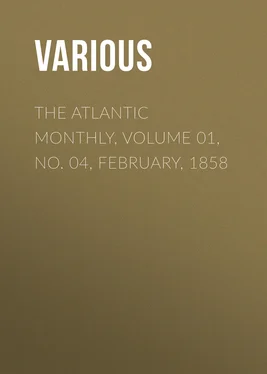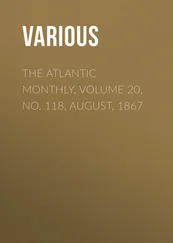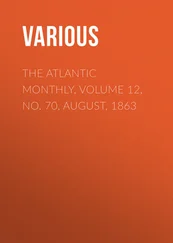Various - The Atlantic Monthly, Volume 01, No. 04, February, 1858
Здесь есть возможность читать онлайн «Various - The Atlantic Monthly, Volume 01, No. 04, February, 1858» — ознакомительный отрывок электронной книги совершенно бесплатно, а после прочтения отрывка купить полную версию. В некоторых случаях можно слушать аудио, скачать через торрент в формате fb2 и присутствует краткое содержание. Жанр: foreign_antique, periodic, foreign_edu, на английском языке. Описание произведения, (предисловие) а так же отзывы посетителей доступны на портале библиотеки ЛибКат.
- Название:The Atlantic Monthly, Volume 01, No. 04, February, 1858
- Автор:
- Жанр:
- Год:неизвестен
- ISBN:нет данных
- Рейтинг книги:3 / 5. Голосов: 1
-
Избранное:Добавить в избранное
- Отзывы:
-
Ваша оценка:
- 60
- 1
- 2
- 3
- 4
- 5
The Atlantic Monthly, Volume 01, No. 04, February, 1858: краткое содержание, описание и аннотация
Предлагаем к чтению аннотацию, описание, краткое содержание или предисловие (зависит от того, что написал сам автор книги «The Atlantic Monthly, Volume 01, No. 04, February, 1858»). Если вы не нашли необходимую информацию о книге — напишите в комментариях, мы постараемся отыскать её.
The Atlantic Monthly, Volume 01, No. 04, February, 1858 — читать онлайн ознакомительный отрывок
Ниже представлен текст книги, разбитый по страницам. Система сохранения места последней прочитанной страницы, позволяет с удобством читать онлайн бесплатно книгу «The Atlantic Monthly, Volume 01, No. 04, February, 1858», без необходимости каждый раз заново искать на чём Вы остановились. Поставьте закладку, и сможете в любой момент перейти на страницу, на которой закончили чтение.
Интервал:
Закладка:
CRETINS AND IDIOTS:
Among the numerous philanthropic movements which have characterized the nineteenth century, none, perhaps, are more deserving of praise than those which have had for their object the improvement of the cretin and the idiot, classes until recently considered as beyond the reach of curative treatment.
The traveller, whom inclination or science may have led into the Canton Valais, or Pays-de-Vaud, in Switzerland, or into the less frequented regions of Savoy, Aosta, or Styria, impressed as he may be with the beauty and grandeur of the scenery through which he passes, finds himself startled also at the frightful deformity and degradation of the inhabitants. By the roadside, basking in the sun, he beholds beings whose appearance seems such a caricature upon humanity, that he is at a loss to know whether to assign them a place among the human or the brute creation. Unable to walk,—usually deaf and dumb,—with bleared eyes, and head of disproportionate size,—brown, flabby, and leprous skin,—a huge goitre descending from the throat and resting upon the breast,—an abdomen enormously distended,—the lower limbs crooked, weak, and ill-shaped,—without the power of utterance, or thoughts to utter,—and generally incapable of seeing, not from defect of the visual organs, but from want of capacity to fix the eye upon any object,—the cretin seems beyond the reach of human sympathy or aid. In intelligence he is far below the horse, the dog, the monkey, or even the swine; the only instincts of his nature are hunger and lust, and even these are fitful and irregular.
The number of these unfortunate beings in the mountainous districts of Europe, and especially of Central and Southern Europe, is very great. In several of the Swiss cantons they form from four to five per cent of the population. In Rhenish Prussia, and in the Danubian provinces of Austria, the number is still greater; in Styria, many villages of four or five thousand inhabitants not having a single man capable of bearing arms. In Würtemberg and Bavaria, in Savoy, Sardinia, the Alpine regions of France, and the mountainous districts of Spain, the disease is very prevalent.
The causes of so fearful a degeneration of body and mind are not satisfactorily ascertained. Extreme poverty, impure air, filthiness of person and dwelling, unwholesome diet, the use of water impregnated with some of the magnesian salts, intemperance, (particularly in the use of the cheap and vile brandy of Switzerland,) and the intermarriage of near relatives and of those affected with goitre, have all been assigned, and with apparently good reason; yet there are cases which are attributable to none of these causes.
The disease is not, however, confined to Europe. It is prevalent also in China and Chinese Tartary, in Thibet, along the base of the Himalaya range in India, in Sumatra, in the vicinity of the Andes in South America, in Mexico; and sporadic cases are found along the line of the Alleghanies. It is said not to occur in Europe at a higher elevation than four thousand feet above the sea level.
The derivation of the name is involved in some mystery; most writers regarding it as a corruption of the French Chrétien , as indicative of the incapacity of these unfortunate beings to commit sin. A more probable theory, however, is that which deduces it from the Grison-Romance Cretira , "creature."
The existence of this disease has long been known; references are made to it by Pliny, as well as by some of the Roman writers in the second century of the Christian era; and in the seventeenth and eighteenth centuries its prevalence and causes were frequently discussed. Most of the writers on the subject, however, considered the case of the poor cretin as utterly hopeless; and the few who deemed a partial improvement of his health, though not of his intellect, possible, merely suggested some measures for that purpose, without making any effort to reduce them to practice. It was reserved for a young physician of Zurich, Doctor Louis Guggenbühl, whose practical benevolence was active enough to overcome any repugnance he might feel to labors in behalf of a class so degraded and apparently unpromising, to be the pioneer in an effort to improve their physical, mental, and moral condition.
It is now twenty-one years since this noble philanthropist, then just entering upon the duties of his profession, was first led by some incidents occurring during a tour in the Bernese Alps to investigate the condition of the cretin. For three years he devoted himself to the study of the disease and the method of treating it. Two years of this period were spent in the small village of Seruf, in the Canton Glarus, where he was successful in restoring several to the use of their limbs. It was at the end of this period, that, with a moral courage and devotion of which history affords but few examples, Doctor Guggenbühl resolved to dedicate his life to the elevation of the cretins from their degraded condition. Consecrating his own property to the work, he asked assistance from the Canton Bern in the purchase of land for a hospital, and received a grant of six hundred francs ($120) for the work. His investigations had satisfied him that an elevated and dry locality was desirable, and that it was only the young who could be benefited. He accordingly purchased, in 1840, a tract of about forty acres of land, comprising a portion of the hill called the Abendberg, in the Canton Bern, above Interlachen. The site of his Hospital buildings is about four thousand feet above the sea, and one or two hundred feet below the summit of the hill; it is well protected from the cold winds, and the soil is tolerably fertile.
There are few spots, even among the Alps, which can compare with the Abendberg in beauty and grandeur of scenery. Doctor Guggenbühl was led to select it as much for this reason as for its salubrity, in the belief, which his subsequent experience has fully justified, that the striking nobleness of the landscape would awaken, even in the torpid mind of the cretin, that sense of the beautiful in Nature which would materially aid in his intellectual culture.
On the southern slope of the Abendberg he erected his Hospital buildings, plain, wooden structures, without ornament, but comfortable, and well adapted to his purpose. Here he gathered about thirty cretin children, mostly under ten years of age, and began his work.
To understand fully what was to be accomplished, in order to transform the young cretin into an active, healthy child, it is necessary that we should glance at his physical and mental condition, when placed under treatment.
Cretinism seems to be a combination of two diseases, the one physical, the other mental. The physical disorder is akin to Rachitis , or rickets, while the mental is substantially idiocy. The osseous structure, deficient in the phosphate of lime, is unable to sustain the weight of the body, and the cretin is thus incapacitated for active motion; the muscles are soft and wasted; the skin dingy, cold, and unhealthy; the appetite voracious; spasmodic and convulsed action frequent; and the digestion imperfect and greatly disordered. The mind seems to exist only in a germinal state; observation, memory, thought, the power of combination, are all wanting. The external senses are so torpid, that, for months perhaps, it is in vain to address either eye or ear; nor is the sense of touch much more active. The cretin is insensible to pain or annoyance, and seems to have as little sensation as an oyster.
It was to the work of restoring these diseased and enfeebled bodies to health, and of developing these germs of intellect, that Doctor Guggenbühl addressed himself. For this purpose, pure air, enforced exercise, the use of cold, warm, and vapor baths, of spirituous lotions and frictions, a simple yet eminently nutritive diet, regular habits, and the administration of those medicinal alternatives which would give tone to the system, activity to the absorbents, and vigor to the muscles, were the remedial measures adopted. As their strength increased, they were led to practise the simpler gymnastic exercises,—running, jumping, climbing, marching, the use of the dumb-bells, etc.
Читать дальшеИнтервал:
Закладка:
Похожие книги на «The Atlantic Monthly, Volume 01, No. 04, February, 1858»
Представляем Вашему вниманию похожие книги на «The Atlantic Monthly, Volume 01, No. 04, February, 1858» списком для выбора. Мы отобрали схожую по названию и смыслу литературу в надежде предоставить читателям больше вариантов отыскать новые, интересные, ещё непрочитанные произведения.
Обсуждение, отзывы о книге «The Atlantic Monthly, Volume 01, No. 04, February, 1858» и просто собственные мнения читателей. Оставьте ваши комментарии, напишите, что Вы думаете о произведении, его смысле или главных героях. Укажите что конкретно понравилось, а что нет, и почему Вы так считаете.












